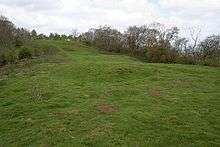Warren
A warren is a network of wild rabbit burrows. Domestic warrens are artificial, enclosed establishment of animal husbandry dedicated to the raising of rabbits for meat and fur. The term evolved from the medieval Anglo-Norman concept of free warren, which had been, essentially, the equivalent of a hunting license for a given woodland.
Architecture of the domestic warren
The cunicularia of the monasteries may have more closely resembled hutches or pens, than the open enclosures with specialized structures which the domestic warren eventually became. Such an enclosure or close was called a cony-garth, or sometimes conegar, coneygree or "bury" (from "burrow").
Moat and pale
To keep the rabbits from escaping, domestic warrens were usually provided with a fairly substantive moat, or ditch filled with water. Rabbits generally do not swim and avoid water. A pale, or fence, was provided to exclude predators.
Pillow mounds

The most characteristic structure of the "cony-garth" ("rabbit-yard")[1] is the pillow mound. These were "pillow-like", oblong mounds with flat tops, frequently described as being "cigar-shaped", and sometimes arranged like the letter ⟨E⟩ or into more extensive, interconnected rows. Often these were provided with pre-built, stone-lined tunnels. The preferred orientation was on a gentle slope, with the arms extending downhill, to facilitate drainage. The soil needed to be soft, to accommodate further burrowing.[2]
This type of architecture and animal husbandry has become obsolete, but numerous pillow mounds are still to be found in Britain, some of them maintained by English Heritage, with the greatest density being found on Dartmoor.[3]
Further evolution of the term
Ultimately, the term "warren" was generalized to include wild burrows:[4]
The word thus became used of a piece of ground preserved for these beasts of warren. It is now applied loosely to any piece of ground, whether preserved or not, where rabbits breed (see FOREST LAWS).
The use is further extended to any system of burrows, e.g., "prairie dog warren". By 1649, the term was applied to inferior, crowded human accommodations and meant "cluster of densely populated living spaces" (OED). Contemporarily, the leading use seems to be in the stock phrase "warren of cubicles" in the workplace.
References
- English Garth "small, enclosed plot" is from Old Norse garðr "yard, courtyard, fence".
- See Schematic diagram of a pillow mound.
- The One Show, BBC One news programme. Transmitted on April 24, 2013.
- Chisholm, Hugh, ed. (1911). . Encyclopædia Britannica. 28 (11th ed.). Cambridge University Press. p. 331. see also . Encyclopædia Britannica. 10 (11th ed.). 1911. p. 645.